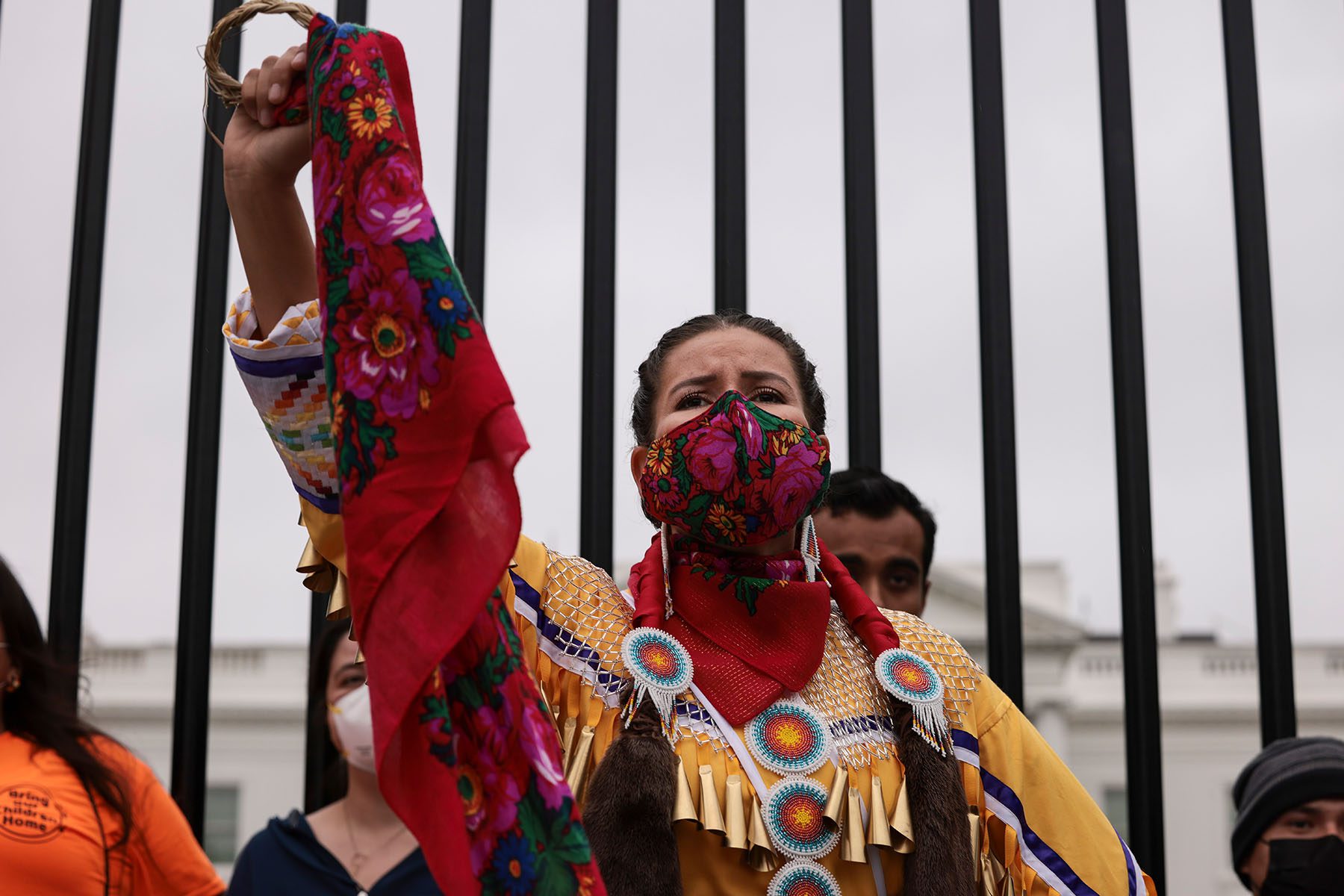*Correction appended.
Native American women make 51 cents for every dollar earned by non-Latino White men in 2021. It would take almost a full additional year to catch up on earnings, but their Equal Pay Day is being observed on November 30, the last day of Native American Heritage Month.
Historically, Native American women have never been adequately compensated for their labor due to the systemic effects of colonization, says a report published ahead of Wednesday’s observance by advocacy group National Women’s Law Center. This wage gap can lead to losses of over $1.1 million over a 40-year career compared with non-Latino White men.
Native women tend to have less job mobility and were among those hit hardest by pandemic losses, says Noreen Farrell, director of Equal Rights Advocates, the organization that leads the Equal Pay Day campaign. They were also slower to be rehired back at their old jobs and are disproportionately part-time workers, who are generally paid less than their full-time counterparts.
However, it’s unclear how accurate these pay statistics are, as Native Americans are undercounted in many Census surveys. One of the main issues is definitions, said Jeffrey Burnette, assistant professor in the department of anthropology and sociology at Rochester Institute of Technology. The American Community Survey, which Equal Rights Advocates uses for its pay day calculations, asks for tribal affiliation. That encompasses anyone who believes they have an Indigenous ancestor (which for many isn’t true) to enrolled citizens of sovereign nations.
Another issue stems from data collection. “One of the things that we know is that the American Community Survey struggles, much like the Census does, with getting good samples in rural areas and areas where people are in poverty, and for a number of historically marginalized groups,” Burnette said.
For Native women, lower economic security makes it difficult to risk unemployment when looking for a new job. It’s hard for Indigenous women to negotiate better benefits or pay — or even to report sexual harassment, Farrell said.
Farrell emphasizes that the wealth gap isn’t tied solely to differences in salaries. “We know that there's historic barriers to economic opportunity for Native women, and they just get compounded when it comes to pay,” she said. “There's a lack of affordable health care access, equity, reproductive health care access and a lack of food sovereignty for Native American women. And all of these things come in a perfect storm when there isn't enough money in the paycheck.”
The wealth gap also stems from systemic colonialism. In 2015 the 1.89 billion acres that make up the United States, land formerly held by Native Americans, was estimated to be worth $23 trillion. Indigenous peoples were forcibly removed from their ancestral lands and relocated to reservations in remote areas. While only 13 percent of Native Americans today live on reservations or tribal land trusts, 60 percent live in metropolitan areas — the smallest share of any racial minority. This often means they are farther from resources and opportunities.
Diana Bigby is the program manager for Native Women Launch, a program that seeks to provide education on business and personal finance to Indigenous women. She sees the legacy of colonialism as one of the unique challenges Native women face versus other racial groups. “I think institutionalized racism is a big part of our lives, whether we want to acknowledge that or not, because living on a reservation or trying to succeed off of a reservation is really hard for someone like me to do,” she said.
Child care is especially challenging to find in remote areas, Bigby said. She is Nakota and lives on the Fort Belknap reservation in northern Montana. The reservation has a population of 3,302, and 39.5 percent live under the poverty line, according to the 2020 American Community Survey. As a mother of five, she understands the struggle many women face when trying to balance caregiving responsibilities, a job and a side hustle.
As a part of Native Women Launch, Bigby works to support Native American women entrepreneurs. She said when the group surveyed business owners at an event earlier this year, the most common requests for support were around first steps — like finding funding or registering a business.
Another consequence of location is that a lack of internet access directly stifles opportunities. “When you live in a low-income area not everybody has a cellphone, not everybody knows to use their email,” Bigby said. “You're like, oh, wait, it's 2022. We're in the technological age, but if you go on a reservation or a low-income community, the access to many different things that you maybe have access to in Missoula aren't around this area.”
The remoteness of the reservation makes commuting to areas with more jobs difficult. Bigby said most of the jobs available on the Fort Belknap reservation are with the tribal government.
Jaime Gloshay has felt the economic injustice of pay inequity firsthand. “Up until my 35th year of life, I, with a master's degree, with tons of experience at the federal, state, local, corporate level, was making like $16 an hour supporting a family of five,” she told The 19th. She had always been entrepreneurial, selling one-cent bookmarks door-to-door as a child, but not being able to make a living wage for over a decade underscored for her the need for Native women to run their own businesses. She also witnessed a deep distrust of lending systems while working at a community development financial institution, which cemented the need for community-led solutions.
Her experiences, plus those of others in her community, and research on barriers to economic security for Native Americans led Gloshay to found Native Women Lead with seven other women in 2017.
Gloshay, who currently serves as the organization’s co-director of building and impact, is from the Navajo, White Mountain Apache and Kiowa Nations and currently lives in Albuquerque. The organization seeks to close the racial wealth gap by creating a “network of care” for Native American women. “Entrepreneurship is one pathway to fight pay inequity, because Indigenous women can essentially claim their wage,” said Gloshay.
One of the goals of Native Women Lead is to create capital that makes sense for their communities. Discriminatory credit practices make it difficult for Native Americans to obtain loans or open lines of credit, and there are additional legal challenges to homeownership in tribal lands.
“Unfortunately, when people don't have access to capital, they also don't have access to opportunities to build wealth. There's not a lot of intergenerational wealth transfer within our communities,” Gloshay said.
“How do we create a place that feels safe for people to look at finances, be real about finances, and feel deserving of accessing and building wealth?”
Creating a new system for the community also allows for trauma-aware policies. People’s experiences, such as with predatory lending or living paycheck to paycheck, can shape how they handle finances.
Designing solutions within communities is one way to address pay inequity, as is increasing financial literacy. Bigby proposed employers recognizing how Native American women can contribute beyond their job duties, by valuing cultural knowledge and community connections, as a way to bridge the pay gap.
Farrell highlighted the importance of pay transparency laws as a way to increase equity, and called on Congress to pass the Paycheck Fairness Act. Rep. Sharice Davids, one of the first Native American women elected to Congress, has said it could help close the pay gap for Indigenous women.
“Wages have risen overall in the last year, but too often we take statistics like that at face value without examining if the rising tide really is reaching all boats,” Davids said in a statement to The 19th. “Clearly, Native women are not seeing the full impact of that trend, and we must continue to support policies like the Paycheck Fairness Act that address this disparity.”
Davids is one of the current co-sponsors of the bill, which was first introduced in 1997. The legislation has passed the House and died in the Senate four times, most recently in 2021.
With 55 percent of Native American mothers serving as the sole breadwinners for their families, the cascading effects of pay inequity are clear.
“We're trying to make the connection around how economic safety and security actually leads to overall human safety,” said Gloshay.
Correction: An earlier version of this article misstated the nations Jaime Gloshay is from. She is from the Navajo, White Mountain Apache and Kiowa nations.







